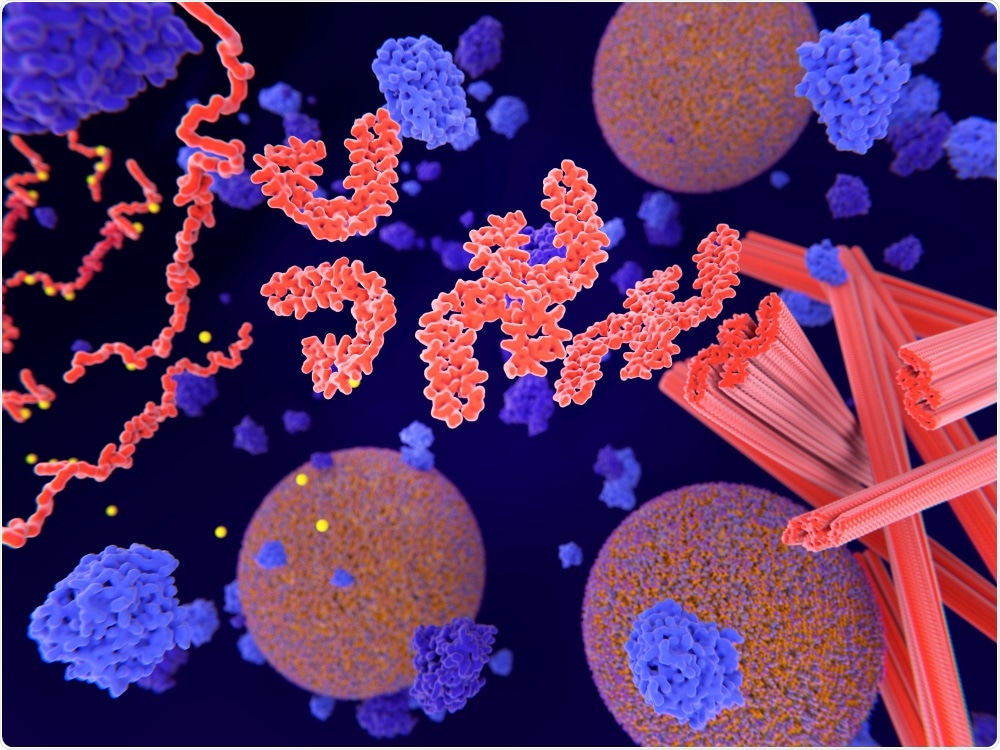With your good chance of getting dementia this test should be prescribed by your doctor to establish a baseline for you. And then if found implement THOSE EXACT DEMENTIA PREVENTION PROTOCOLS your doctor should have competently already set up.
Your risk of dementia, has your doctor told you of this?
1. A documented 33% dementia chance post-stroke from an Australian study? May 2012.
2. Then this study came out and seems to have a range from 17-66%. December 2013.`
3. A 20% chance in this research. July 2013.
4. Dementia Risk Doubled in Patients Following Stroke September 2018
The latest here:
Novel biomarker effectively detects Alzheimer's disease before symptoms emerge
A newly developed radiotracer can measure increases in brain tau—a protein key to the onset and development of Alzheimer's disease – at least a year prior to the emergence of other symptoms.

Tau Protein. Image Credit: Juan Gaertner/Shutterstock.com
Biomarker based on Tau proteins may elucidate patterns of Alzheimer’s disease
Alzheimer’s disease remains a common neurological disorder, with as many as 5.8 million Americans living with Alzheimer’s disease in 2020. Generally, diagnoses for Alzheimer’s disease are based upon cognitive difficulties including memory loss, poor judgment, or mood changes. However, such symptoms are often difficult to identify and monitor.
In new research presented at the Society of Nuclear Medicine and Molecular Imaging 2021 Annual Meeting, researchers demonstrated the use of a new biomarker to identify, track, and measure the effectiveness of treatments of Alzheimer’s disease.
The Society of Nuclear Medicine and Molecular Imaging (SNMMI) is an international scientific and medical organization focused on the development of new treatments as well as the refinement of existing practices.
The new study employed a radiotracer used in PET imaging, termed 18F-MK6240, and was used to detect patterns and rates of tau accumulation in both a cognitively normal aging population and those with Alzheimer's disease.
Tau protein is a key family of proteins expressed in brain neurons but individuals with neurological disorders may present chemical changes that cause tau proteins to accumulate in parts of the brain. Indeed, the Tau protein family has roles primarily in maintaining the stability of microtubules in axons and is abundant in the neurons of the central nervous system.
Accordingly, researchers targeted this protein as a biomarker to measure disease progression. Tracking Tau protein accumulation is particularly insightful as it serves as a proxy for the functionality of the protein.
PET scans were performed on participants in cognitive and affected individuals at baseline and after 12 months, after which the uptake of the 18F-MK6240 radiotracer was measured in multiple areas of the brain.
Results from the PET scans showed that radiotracer uptake was higher at baseline and after one year in participants affected by Alzheimer's disease relative to cognitively normal individuals.
An effective tool for clinical diagnosis and treatments for Alzheimer's disease
The central application of the new radiotracer relies primarily on the identification and treatment of Alzheimer's disease. Tau protein accumulation may serve as a signal that precedes the onset of further symptoms, allowing clinicians to detect potential neurodegenerative patterns prior to further damage.
Christopher Rowe, director of molecular imaging research at Austin Health and director of the Australian Dementia Network in Melbourne, Australia, explains that
The effectiveness of the 18F-MK6240 tracer is important for drug trials that aim to measure whether or not treatments to remove tau from the brain are actually working. The radiotracer will allow researchers to select people at different stages of Alzheimer's disease for clinical trials, which ultimately may speed the development of effective treatments for the disease."
Christopher Rowe, Director of molecular imaging research at Austin Health
Further research on the exact mechanisms of Tau accumulation may help refine the development of the biomarker. Biomarkers have gained increasing interest in clinical research as they provide neurological or physiological proxies used for a wide variety of physical or mental illnesses. As such, future research may also provide further insight into whether the accumulation of different proteins or toxins could lead to other neurodegenerative diseases.
- Diagnostic Imaging. (n.d.). PET Imaging Reveals Efficacy of Novel Cancer Treatment. [online] Available at: https://www.diagnosticimaging.com/view/pet-imaging-reveals-efficacy-of-novel-cancer-treatment [Accessed 15 Jun. 2021].

No comments:
Post a Comment